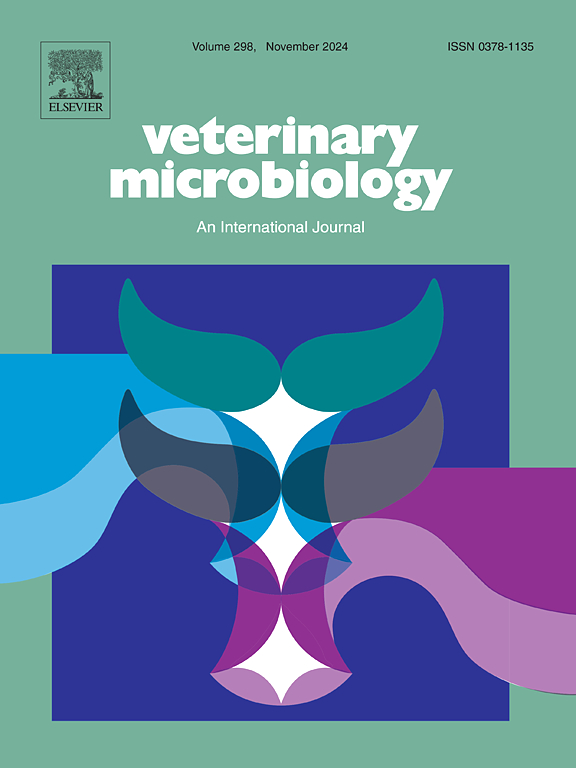副结核分枝杆菌分离株对铜离子处理产生的活性氧压力的反应。
IF 2.4
2区 农林科学
Q3 MICROBIOLOGY
引用次数: 0
摘要
铜(Cu)离子在灭活细菌(包括副结核分枝杆菌(MAP))方面的功效已得到公认,而副结核分枝杆菌是约翰氏病(JD)的致病菌,以其对不利条件的适应能力而闻名。然而,从奶牛体内分离出的 MAP 菌株对铜暴露的反应仍未得到充分了解,因为它们的反应可能与实验室适应性参考菌株的反应不同。在本研究中,我们研究了从MAP感染和患病奶牛体内分离出的MAP菌株对铜离子处理的反应,并将其与参考菌株ATCC 19698对相同处理的反应进行了比较。将三种 MAP 现场分离株和 MAP 参考菌株暴露于 Cu 离子,并以一式三份的方式评估它们的存活率、蛋白质/脂质损伤、ROS 生成和基因表达。不同分离株的存活率不同,其中来自临床 JD 牛的分离株对铜暴露的耐受性更强。虽然铜处理会诱导所有分离株发生脂质过氧化反应和产生 ROS,但与铜解毒和毒力相关的基因上调,尤其是在参考菌株中。全基因组测序分析表明,尽管野外分离菌株与参考菌株 ATCC 19698 的基因组相似,但在某些毒力因子相关基因的存在/缺失方面存在差异。需要对更多的 MAP 分离物进行铜暴露的进一步研究,以解释影响 MAP 在自然感染和挑战性环境中存活的压力诱导反应。本文章由计算机程序翻译,如有差异,请以英文原文为准。
Response of Mycobacterium avium subsp. paratuberculosis isolates to reactive oxygen stress generated by treatment with copper ions
Copper (Cu) ions have been recognized for their efficacy in inactivating bacteria, including Mycobacterium avium subsp. paratuberculosis (MAP), the causative agent of Johne’s disease (JD) known for its resilience to unfavorable conditions. However, the response of MAP isolates isolated from cows to Cu exposure remains inadequately understood, as their responses may differ from those of laboratory-adapted reference strains. In this study, we examined the response of MAP isolates obtained from MAP-infected and affected cows to Cu ion treatment, comparing that with the response of the reference strain ATCC 19698 to the same treatment. Three MAP field isolates and the MAP reference strain were exposed to Cu ions, and their viability, protein/lipid damage, ROS production, and gene expression were evaluated in triplicate. Survival differed among isolates, with an isolate from a cow with clinical JD exhibiting increased tolerance to Cu exposure. While Cu treatment induced lipid peroxidation and ROS production across all isolates, genes associated with Cu detoxification and virulence were upregulated, particularly in the reference strain. Whole genome sequencing analysis revealed that, despite genomic similarities between field isolates and the reference strain ATCC 19698, there were differences regarding the presence/absence of genes related with certain virulence factors. Further research on Cu exposure with larger numbers of MAP isolates is needed to explain the stress-induced responses that influence MAP survival during natural infections and in challenging environments.
求助全文
通过发布文献求助,成功后即可免费获取论文全文。
去求助
来源期刊

Veterinary microbiology
农林科学-兽医学
CiteScore
5.90
自引率
6.10%
发文量
221
审稿时长
52 days
期刊介绍:
Veterinary Microbiology is concerned with microbial (bacterial, fungal, viral) diseases of domesticated vertebrate animals (livestock, companion animals, fur-bearing animals, game, poultry, fish) that supply food, other useful products or companionship. In addition, Microbial diseases of wild animals living in captivity, or as members of the feral fauna will also be considered if the infections are of interest because of their interrelation with humans (zoonoses) and/or domestic animals. Studies of antimicrobial resistance are also included, provided that the results represent a substantial advance in knowledge. Authors are strongly encouraged to read - prior to submission - the Editorials (''Scope or cope'' and ''Scope or cope II'') published previously in the journal. The Editors reserve the right to suggest submission to another journal for those papers which they feel would be more appropriate for consideration by that journal.
Original research papers of high quality and novelty on aspects of control, host response, molecular biology, pathogenesis, prevention, and treatment of microbial diseases of animals are published. Papers dealing primarily with immunology, epidemiology, molecular biology and antiviral or microbial agents will only be considered if they demonstrate a clear impact on a disease. Papers focusing solely on diagnostic techniques (such as another PCR protocol or ELISA) will not be published - focus should be on a microorganism and not on a particular technique. Papers only reporting microbial sequences, transcriptomics data, or proteomics data will not be considered unless the results represent a substantial advance in knowledge.
Drug trial papers will be considered if they have general application or significance. Papers on the identification of microorganisms will also be considered, but detailed taxonomic studies do not fall within the scope of the journal. Case reports will not be published, unless they have general application or contain novel aspects. Papers of geographically limited interest, which repeat what had been established elsewhere will not be considered. The readership of the journal is global.
 求助内容:
求助内容: 应助结果提醒方式:
应助结果提醒方式:


